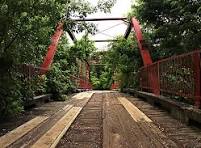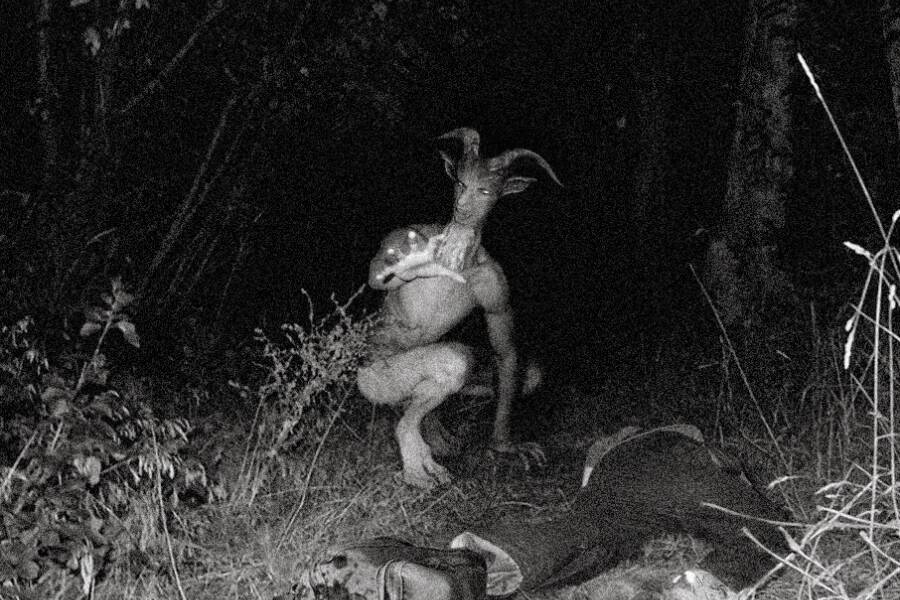The Specter of Goat Man's Bridge
By The Astonished StorytellerIn the shadowy recesses of the human mind, where the twilight of reason gives way to the phantoms of imagination, there lies a tale—dark and dreadful—a tale that entwines the very essence of fear with the sinews of existence. It is a legend whispered through generations, a murmur carried by the wind that sighs through the gnarled trees of Denton County. This is the tale of Goat Man's Bridge, where the specter of a forgotten soul lingers, forever bound by the chains of an unspeakable past.
 It was in the year of our Lord 1860, when the bridge, now known as Goat Man's Bridge, was constructed. It spanned the murky waters of Hickory Creek, a solitary sentinel amidst the verdant wilderness. The bridge, though a marvel of human ingenuity, became a vessel for a malevolent force—an entity born of hatred and sorrow, an entity whose name would forever be etched in the annals of terror: Oscar Washburn.
It was in the year of our Lord 1860, when the bridge, now known as Goat Man's Bridge, was constructed. It spanned the murky waters of Hickory Creek, a solitary sentinel amidst the verdant wilderness. The bridge, though a marvel of human ingenuity, became a vessel for a malevolent force—an entity born of hatred and sorrow, an entity whose name would forever be etched in the annals of terror: Oscar Washburn.
Oscar Washburn was a man of humble origins, a man who toiled beneath the relentless Texan sun, a man who, by the sweat of his brow, carved a living out of the unforgiving land. He was a goat herder, a vocation inherited from generations past, and one that earned him the moniker "Goat Man." Washburn was known for his fairness and honesty, a beacon of integrity in a world often shrouded in duplicity.
Yet, as the wheel of fate turned, darkness cast its pall over Washburn's life. The whispering pines and rustling leaves spoke of discontent among the townsfolk—discontent fueled by ignorance and bigotry. Washburn, a man of color in a time when such a thing was met with disdain and distrust, became the target of their malice.
On a night when the moon hung low in the sky, veiled by a shroud of tempestuous clouds, a cabal of men—faces obscured by the shadow of hatred—descended upon Washburn's humble abode. They came with torches ablaze, their minds consumed by a fervor most foul. With cruel hands and hearts hardened by prejudice, they dragged the hapless Washburn to the bridge, the very symbol of his prosperity, and there, they committed an act so vile that the heavens themselves wept in sorrow.
Washburn was bound and beaten, his cries echoing through the night like the wails of a forlorn spirit. The mob, driven by a frenzy of loathing, hung him from the bridge—a sacrifice to their insatiable wrath. His lifeless body swayed in the wind, a grim testament to the depths of human cruelty.
But death, that eternal slumber, was not the end for Oscar Washburn. As his soul departed the mortal coil, it became ensnared by the tendrils of vengeance and sorrow, a wraith forged in the crucible of despair. His specter, eyes aglow with an ethereal light, lingered upon the bridge—a harbinger of doom, a sentinel of the night.
The years passed, and the legend of Goat Man's Bridge grew, nourished by the fears and superstitions of those who dared to traverse its haunted span. Travelers spoke in hushed tones of a ghostly figure, half-man, half-goat, who roamed the bridge at the witching hour. Some claimed to hear the clatter of hooves upon the wooden planks, others swore they saw a pair of burning eyes staring at them from the darkness.
One such tale is that of Abigail Marsh, a young woman whose beauty was rivaled only by her curiosity. Drawn by the allure of the unknown, she ventured to the bridge on a moonless night, her heart pounding with a mixture of fear and excitement. The air was thick with an oppressive silence, broken only by the occasional rustle of leaves.
As she stepped onto the bridge, a chill ran down her spine. The temperature plummeted, and the hairs on her arms stood on end. In the distance, she saw a figure—a man draped in tattered rags, his eyes glowing with an otherworldly fire. Abigail's breath caught in her throat as the figure began to move towards her, its form shifting and contorting into something monstrous.
She tried to flee, but her legs refused to obey, as if the very air had turned to lead. The specter drew closer, its visage twisted in a grotesque parody of humanity. It reached out with a clawed hand, and as its fingers brushed against her skin, a scream tore from her lips—a scream that echoed through the night, carrying with it the terror of a thousand souls.
Abigail was found the next morning, lying unconscious at the edge of the bridge. Her hair had turned white, and her eyes, once full of life, were now vacant and hollow. She spoke not a word of what she had seen, for the horrors she had witnessed had robbed her of her voice.
The townsfolk, their fears rekindled, spoke of the curse that lay upon the bridge, a curse born of Washburn's unquiet spirit. They erected signs, warning travelers to steer clear of the haunted span, but the lure of the unknown proved too strong for some. Stories of encounters with the Goat Man continued to emerge—each more chilling than the last.
One such account comes from the journal of Jonathan Harker, an itinerant preacher who, driven by a desire to cleanse the land of its unholy blight, journeyed to Goat Man's Bridge. Harker was a man of fervent faith, and he believed that with the power of prayer, he could banish the specter and bring peace to Washburn's tormented soul.
He arrived at the bridge on a stormy night, the heavens ablaze with lightning and the air thick with the scent of impending rain. Harker stood at the center of the bridge, his Bible clutched tightly in his hands, and began to recite passages of exorcism, his voice rising above the howling wind.
As he spoke, the temperature plummeted, and a dense fog enveloped the bridge. Harker's words faltered as a figure emerged from the mist—a figure with the body of a man and the head of a goat, its eyes burning with an unholy fire. The specter approached, and Harker felt a chill seep into his bones, a cold so profound it seemed to freeze his very soul.
With a trembling hand, Harker raised his Bible, but the specter swatted it away with a contemptuous snarl. The Goat Man's voice, a guttural whisper that seemed to emanate from the depths of the abyss, echoed in Harker's mind. "Leave this place, mortal," it hissed, "for it is cursed by the sins of your kind."
Harker, his resolve wavering, took a step back. But before he could flee, the specter reached out, its clawed hand gripping his shoulder with a strength born of the grave. A surge of agony coursed through Harker's body, and he collapsed to the ground, his vision blurring as darkness claimed him.
He awoke at dawn, the storm having passed, and found himself lying at the edge of the bridge. His body was racked with pain, and his mind was haunted by the specter's words. He returned to the town, a broken man, his faith shattered by the encounter. He spoke of the curse that lay upon the bridge, warning all who would listen to steer clear of its haunted span.
Yet, despite the warnings, the allure of Goat Man's Bridge remained. It became a place of morbid fascination, a magnet for thrill-seekers and paranormal enthusiasts. Some came in search of proof of the supernatural, others driven by a desire to confront their deepest fears. Few returned unscathed, their encounters with the specter leaving them forever changed.
One such individual was Marcus Blake, a renowned paranormal investigator whose skepticism was matched only by his determination. Armed with an array of scientific instruments, Blake ventured to the bridge on a night when the moon was obscured by a thick blanket of clouds. He set up his equipment, determined to capture evidence of the spectral presence.
As the night wore on, Blake's instruments registered fluctuations in temperature and electromagnetic fields. He documented strange noises—whispers that seemed to come from nowhere, footsteps that echoed in the stillness. But it was not until the witching hour that he encountered the specter itself.
Blake was reviewing his notes when a sudden chill filled the air. He looked up and saw a figure standing at the far end of the bridge—a figure with the body of a man and the head of a goat. The specter's eyes glowed with an eerie light, and a sense of dread washed over Blake.
Determined to confront the entity, Blake advanced, his camera rolling. As he approached, the specter began to shift and contort, its form becoming more monstrous with each step. Blake raised his camera, but the specter swatted it aside, sending it crashing to the ground.
The specter reached out, its clawed hand gripping Blake's arm with a strength that belied its spectral nature. A wave of pain surged through Blake's body, and he felt his consciousness slipping away. As darkness claimed him, he heard the specter's voice, a guttural whisper that seemed to resonate within his very soul.
 "Leave this place, mortal, for it is cursed by the sins of your kind."
"Leave this place, mortal, for it is cursed by the sins of your kind."
Blake awoke at dawn, lying at the edge of the bridge. His body was racked with pain, and his mind was haunted by the specter's words. He returned to the town, his skepticism shattered by the encounter. He spoke of the curse that lay upon the bridge, warning all who would listen to steer clear of its haunted span.
The legend of Goat Man's Bridge endures, a dark testament to the depths of human cruelty and the lingering power of vengeance. The specter of Oscar Washburn remains, a sentinel of the night, bound by the chains of an unspeakable past. Those who dare to cross the bridge at the witching hour may find themselves face to face with the Goat Man, their souls forever marked by the encounter.
And so, the bridge stands—a monument to the sins of the past, a gateway to the unknown. Its wooden planks creak under the weight of time, and its shadows whisper of forgotten horrors. The wind that sighs through the gnarled trees carries with it the murmur of a name—a name that will forever be etched in the annals of terror: Oscar Washburn, the Goat Man.
